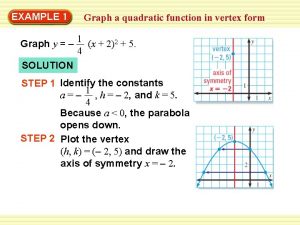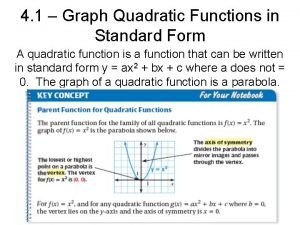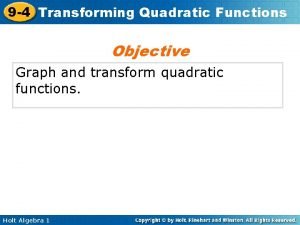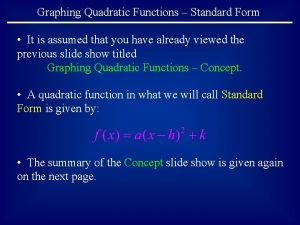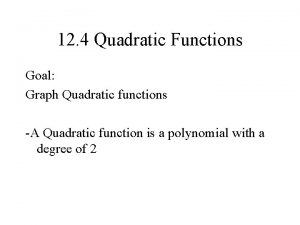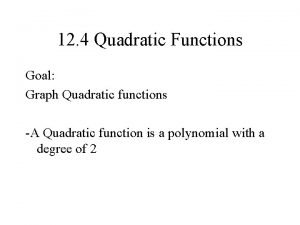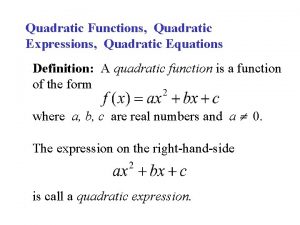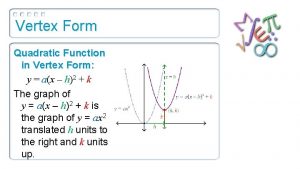Section 4 2 Graph Quadratic Functions in Vertex













- Slides: 13

Section 4. 2: Graph Quadratic Functions in Vertex or Intercept Form

Vertex form – an equation in the form y = a(x – h)2 + k.

Graph of Vertex Form y = a(x – h)2 + k The graph of y = a(x – h)2 + k is the parabola y = ax 2 translated horizontally h units and vertically k units. Characteristics of the graph of y = a(x – h)2 + k • The vertex is (h, k). • The axis of symmetry is x = h. • The graph opens up if a > 0 and down if a < 0.

Example 1: Graph y = ½(x – 3)2 – 5 Label the vertex and axis of symmetry.

Example 2: Graph y = -(x – 1)2 + 5

HOMEWORK (Day 1) pg. 249; 4 – 9

If the graph of a quadratic function has at least one x-intercept, then the function can be represented in intercept form, y = a(x – p)(x – q). Characteristics of the graph of y = (x – p)(x – q) • The x-intercepts are p and q. • The axis of symmetry is halfway between (p, 0) and (q, 0). It has the equation. • The graph opens up if a > 0 and opens down if a < 0.

Example 3: Graph y = (x – 3)(x – 7). Label the vertex, axis of symmetry, and x-intercepts.

Example 4: Graph y = -(x + 1)(x – 5)

FOIL Method To multiply two expressions that each contain two terms, add the products of the First terms, the Outer terms, the Inner terms, and the Last terms. (x + 4)(x + 7) = x 2 + 11 x + 28

Example 5: Write the following in standard form. a) y = 3(x – 4)(x + 6) y = 3 x 2 + 6 x – 72 b) f(x) = - ½(x + 8)2 + 35 f(x) = - ½x 2 – 8 x + 3

Example 6: Find the minimum value or the maximum value of the function. a) y = 3(x – 3)2 – 4 minimum -4 b) g(x) = -5(x + 9)(x – 4) maximum 211. 25

HOMEWORK (Day 2) pg. 249; 13 – 16, 24 – 40 even
 How to find vertex form from a graph
How to find vertex form from a graph Vertex math
Vertex math 8-2 quadratic functions
8-2 quadratic functions Transformations of quadratic functions
Transformations of quadratic functions How to find the vertex of a parabola
How to find the vertex of a parabola Example of narrowest graph
Example of narrowest graph How to graph a function in standard form
How to graph a function in standard form Using transformations to graph quadratic functions
Using transformations to graph quadratic functions Translating quadratic functions
Translating quadratic functions 9-4 practice b transforming quadratic functions
9-4 practice b transforming quadratic functions How to know if a graph opens up or down
How to know if a graph opens up or down How to graph quadratic functions in standard form
How to graph quadratic functions in standard form How to graph quadratic functions in intercept form
How to graph quadratic functions in intercept form Using transformations to graph quadratic functions
Using transformations to graph quadratic functions




